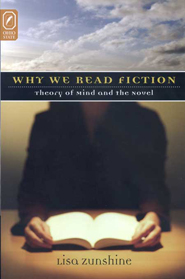A few years ago when reality television became 'the next big thing,' a lot of time was devoted to figuring out its appeal. Was it the stunts? The crazy situations? The relationships? Lisa Zunshine, who holds the Bush-Holbrook Professorship in the UK Department of English, theorizes that it is really about feeding a deeply seated evolutionary need.
Think about it. Reality shows use techniques that focus on the moments that most people try to conceal. Confession booths. Night-cams. Overheard private conversations. The audience seemingly has perfect access to the participants’ true thoughts and feelings.
“Such cultural representations make you feel like an extremely accomplished social player when you are confronted with those moments of apparently perfect access,” explained Zunshine. “They manipulate us into believing that we know what a person is thinking and feeling right now even though he or she is trying to conceal her feelings.”
Zunshine is one of the leading scholars in the emerging field of cognitive cultural studies, which melds literary theory with cognitive psychology. In particular, she seeks to apply research in theory of mind to works of fiction, such as novels, and to visual representations, such as movies, television, and graphic narratives.
 Theory of mind, also known as mind-reading, is a term used by psychologists and philosophers of mind to describe our evolved cognitive ability to explain observable behavior in terms of unobservable mental states such as thoughts, desires, and intentions. According to Zunshine, “our daily lives would be unimaginable without constant attribution of mental states, which is fast, intuitive, mostly unconscious and not verbalized, and also frequently incorrect.” Someone reaches for a glass of water and we assume they are thirsty. Someone glances at a clock and we make assumptions about how interesting they find our conversation.
Theory of mind, also known as mind-reading, is a term used by psychologists and philosophers of mind to describe our evolved cognitive ability to explain observable behavior in terms of unobservable mental states such as thoughts, desires, and intentions. According to Zunshine, “our daily lives would be unimaginable without constant attribution of mental states, which is fast, intuitive, mostly unconscious and not verbalized, and also frequently incorrect.” Someone reaches for a glass of water and we assume they are thirsty. Someone glances at a clock and we make assumptions about how interesting they find our conversation.
“Theory of mind evolved to track mental states involved in real-life social interactions,” explains Zunshine. “On some level, however, our theory-of-mind adaptations do not distinguish between the mental states of real people and of fictional characters. We eagerly attribute thoughts, feelings, and intentions to both. Fiction, thus, feeds our theory of mind, giving us carefully crafted, emotionally and aesthetically compelling social contexts shot through with mind-reading opportunities. Hence the pleasure afforded by following minds in fictional narratives is to a significant degree a social pleasure. It’s an illusory but satisfying confirmation that we remain competent players in the social game that is our life.”
Taking the guesswork out of complex social situations is one of many different strategies used by writers to intensify our mind-reading pleasure. Zunshine’s latest book, “Getting Inside Your Head: Culture and the Theory of Mind,” forthcoming from The Johns Hopkins University Press, will explore such strategies as are used in works of fiction, movies, reality television, plays and even paintings to present viewers and readers with moments of perfect access.
"This is what we don’t have in real life,” said Zunshine. “Perfect access doesn’t exist in real life. We attribute mental states to others, but we don’t really know what they think. Whereas, I’m looking at moments in cultural representations when we can really know what characters are thinking.”
 Zunshine’s earlier book, “Why We Read Fiction: Theory of Mind and the Novel,” explored how fictional narratives play and experiment with the reader’s theory of mind and the techniques used by authors to draw readers into the mental states of the characters.
Zunshine’s earlier book, “Why We Read Fiction: Theory of Mind and the Novel,” explored how fictional narratives play and experiment with the reader’s theory of mind and the techniques used by authors to draw readers into the mental states of the characters.
This may sound fairly straightforward but within a given situation, there can be multiple levels of embedded mental states. Think of the classic Friends episode that included the line “They don't know that we know they know we know!” At least four different levels of mental states are embedded within that situation. Zunshine explains that certain works of fiction may embed five or even six levels of mental states. Some of these authors are considered “difficult” writers – Virginia Woolf anyone? – yet others like Jane Austen “do it so subtly that we don’t even notice that we have to process really complicated embedments,” said Zunshine.
This “sociocognitive complexity” – a term coined by Zunshine – that we negotiate as readers is what keeps us coming back for more. “When we read works of fiction, we engage in very sophisticated mind reading, figuring out what one character thinks of another character thinking about another character – and what the author might have thought of all of them.”
This reader-centered approach puts a new spin on “feel good” entertainment as it gives us a window into the human heart.
by Rebekah Tilley
